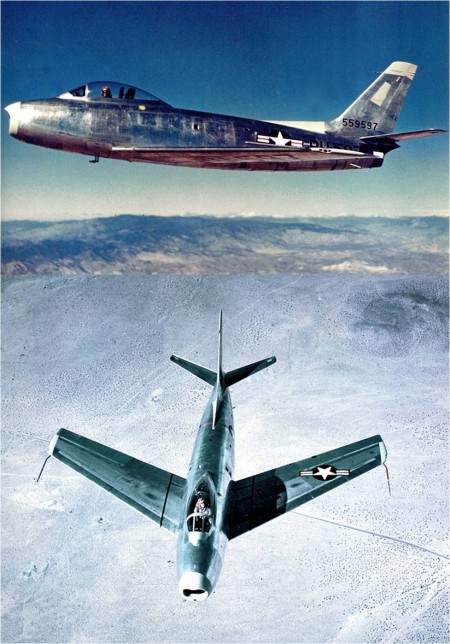Sixty-three years ago this month, a United States Air Force aircraft broke the storied sound barrier for the first time. While the rocket-powered Bell XS-1 is credited in the history books for this achievement, there is ample and compelling evidence that the North American XF-86 Sabre was in fact the first aircraft to exceed Mach One.
October 1947 was a pivotal time in the history of aviation. For it was in that very month and year that a piloted aircraft first safely exceeded the speed of sound. This feat was accomplished by a United States Air Force aircraft, flown by a World War II combat ace, in the skies over a remote desert air base in California.
The common understanding is that (1) the aircraft involved was the Bell XS-1, Ship No. 1 (S/N 46-062), (2) piloted by Captain Charles E. “Chuck” Yeager at (3) Muroc Army Airfield, California. It is a verifiable fact that said aircraft and pilot indeed flew supersonically on Tuesday, 14 October 1947 at the aforementioned location. However, this occasion did not necessarily mark the first time that the sonic wall was successfully penetrated.
While anathema to some, it is averred here that the aircraft that first safely achieved supersonic flight was the North American XF-86 Sabre, Ship No. 1 (S/N 45-59597). This was accomplished with the aircraft in a dive. The pilot of that aircraft was North American test pilot and former Air Force fighter pilot George Schwartz “Wheaties” Welch. Welch exceeded Mach 1 on at least two dates in October of 1947. In particular, the 1st and the 14th of that month.
If you are looking for the official flight records that substantiate the assertions above, you will be disappointed. However, if you are willing to ponder the available anecdotal and circumstantial accounts submitted by numerous eye and earwitnesses, you may want to consider reading the 1998 book entitled “Aces Wild: The Race to Mach 1” by engineering test pilot Albert W. “Al” Blackburn.
I won’t spoil your fun here in delving into Blackburn’s writings. However, suffice it to say that the author’s case is persuasive. And Blackburn, who passed away in 2011, knew whereof he spoke. As an accomplished and respected aviation veteran, he graduated from MIT with a masters degree in Aeronautical Engineering and defended freedom from the air in both World War II and the Korean War.
Al Blackburn flew as a test pilot for the United States Navy at the Naval Air Test Center in Patuxent River, Maryland. Later, he became an engineering test pilot for North American Aviation in Los Angeles, California. Among many distinctions, Al Blackburn made the first flight in the F-100 Zero Length Launch (ZEL) Program. He also served as the third president of the Society of Experimental Test Pilots (SETP).
If you get the feeling that I’m trying to validate Al Blackburn and thus his story about the first to achieve Mach 1, you would be right! That’s because you will hear other voices, some of high aeronautical repute, who vehemently disagree with Blackburn. However, at least in this writer’s view, the collective contentions of the anti’s are easily challenged and ultimately fail to persuade.
While Chuck Yeager is still with us, George Welch is not. He sadly and needlessly perished at the ripe old age of 36 in an infamous F-100A Super Sabre mishap in 1954. However, to the end of his life, Welch steadfastly (and with absolutely no notoriety) maintained that he was indeed the first to Mach 1. For his part, Chuck Yeager is understandably among the naysayers when the topic of Welch being the first to achieve Mach 1 is raised.
After you consider the case presented by Al Blackburn in “Aces Wild”, perhaps you will agree with me that the historical record should be amended to read: Chuck Yeager and the Bell XS-1 were the first to exceed Mach 1 in level flight. George Welch and the North American XF-86 was the first to exceed Mach 1; which exceedance was accomplished in a dive.

